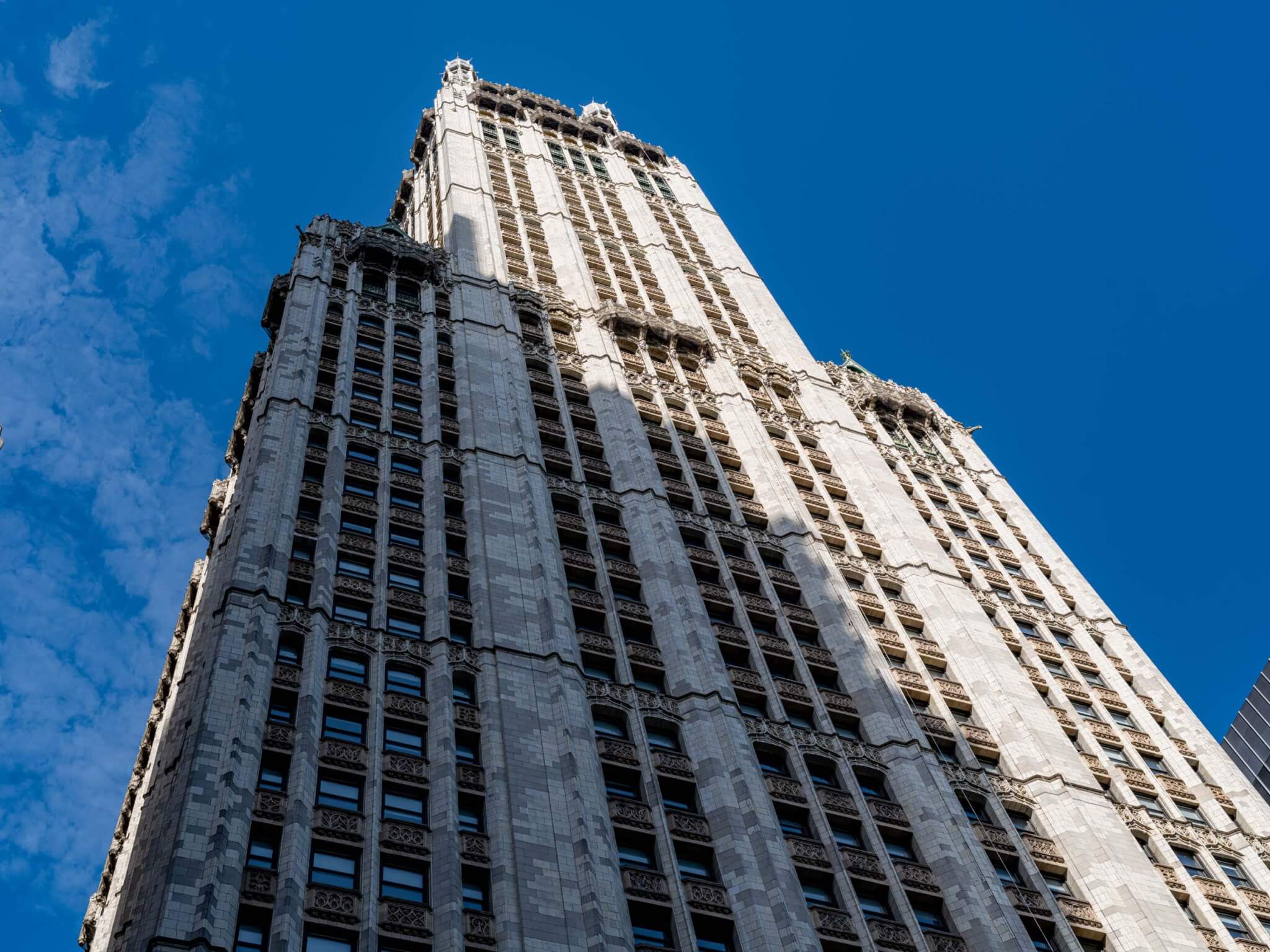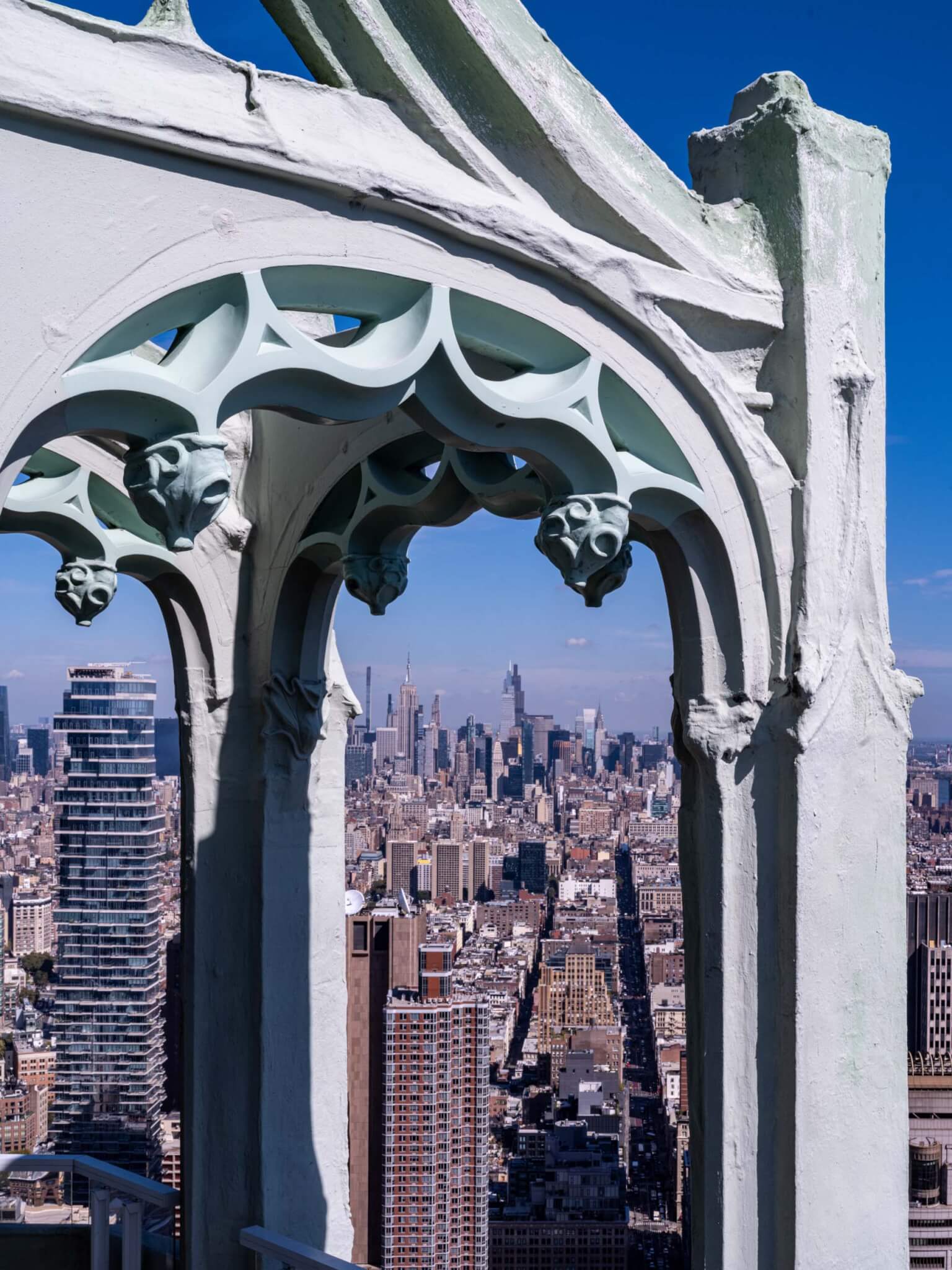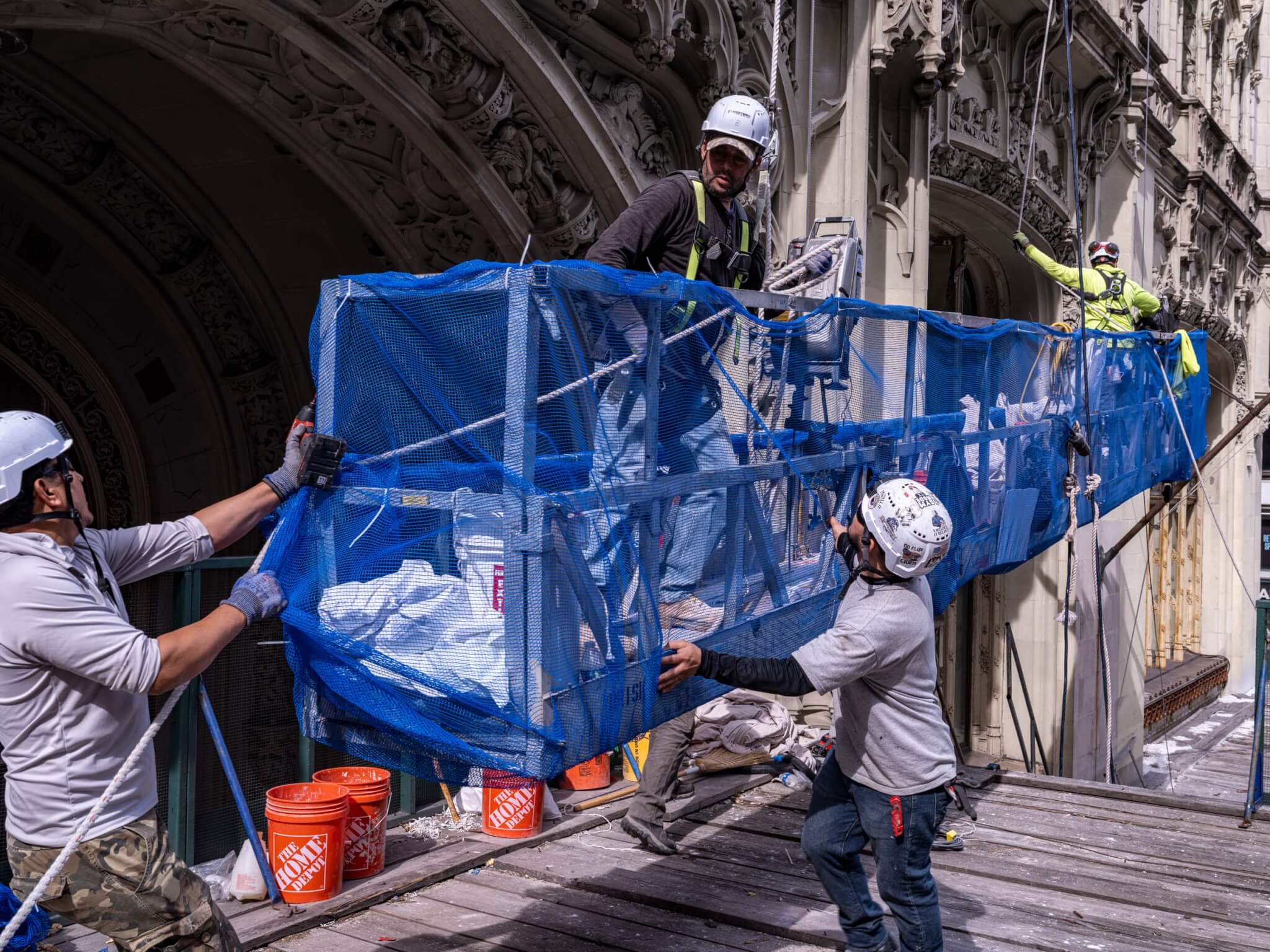When architect Cass Gilbert designed the Woolworth Building, his aim was to show off the building’s 792-foot steel structure. The innovative steel-cage construction, a major engineering feat at the time, would secure the building’s status as the world’s tallest building for over a decade after its 1913 opening. So as not to detract from this technology, he clad the building in limestone and glazed terra-cotta so that no one would think the skyscraper was, as Gilbert said, “pretending to be a masonry building.”
The tower’s light cream facade, enlivened with intricate, neo-Gothic ornamentation, definitively sets it apart from the dull gray of the masonry buildings that Gilbert rejected. However, the Woolworth’s coloration as well as the fragility of porous terra-cotta has meant that the facade has required near constant maintenance during its 112 years of existence. Almost immediately after its completion, workers had to scramble up scaffolding—or be lowered down on cleaning rigs—to scrub layers of city grime off the building’s facade and make cosmetic repairs. Today, restoration efforts continue, but now a new generation is stewarding the landmarked building’s future.
Such Great Heights
Jeremy Edwards is the 29-year-old project manager tasked with leading the latest round of facade restoration on the tower. When we met, he was wearing a corduroy blazer over his work clothes, a hard hat stowed in the crook of his elbow. Often the youngest person on site, Edwards moves with the quiet assurance of someone who holds all the keys to the building. The Woolworth’s security guards, notoriously strict on interlopers hoping for a peek of the lobby’s iconic, landmarked ceilings, waved us through. One added: “If you’re with him, you can go anywhere.”

Soon after, we were standing outside on a terrace on the 28th floor peering over a ledge at the stomach-dropping view toward Park Place far below. “It doesn’t feel like you’re that high up,” Edwards observed. He spends his days scaling the building’s street-facing walls in a harness on a suspended rig, inspecting every single terra-cotta facade component. Once he identifies a repair or replacement that must be made, he draws up the construction documents that initiate the process of restoration carried out by a wider team of terra-cotta fabricators, masonry-restoration firms, scaffold contractors, and other specialists.
In conversation, Edwards compared the composition of Woolworth’s facade to that of a painted balloon. Once the balloon starts to expand and contract, as any building’s steel skeleton inevitably does, cracks can quickly appear on its outer layers. “Sometimes the terra-cotta can’t withstand the compressive forces,” Edwards explained.

He noted that having a holistic approach to restoration is key for buildings like this one: “It might be cracking in one area, but that force is so high that once you touch one part, another piece might break somewhere far above it.”
Edwards’s documentation process is split into 57 vertical sections of the building facade, or “drops,” and can take more than six months. The current cycle is slated to be completed in November. In Edwards’s field office, on an unleased floor of the building, drawings are pinned up to review progress, post-shift equipment is stacked in piles, and terra-cotta pieces sit idly, until Edwards grabs one to illustrate a point. Elsewhere on the floor, safety lines are tied off around drywalled columns before shooting out open windows.

Facade Maintenance Design (or FacadeMD), the company Edwards works for, has held the contract for the building’s facade inspection since 1987. The inspection takes place every five years to align with the required timing through New York City’s Facade Inspection and Safety Program (FISP).
For FacadeMD president Rick Lefever, the Woolworth Building has always been a matter of pride and, as a result, legacy. “It is highly gratifying to be entrusted with the care of this iconic structure, and we have adapted our design approach as restoration technology has evolved,” he told AN. “I was delighted when I placed the souvenir gift from the building’s 100th anniversary gala on my desk, next to the souvenir gift from the 75th anniversary.”


Perhaps that’s why he recognized a successor in Edwards. “One day, after touring the building, my boss [Lefever] asked me how much I knew about terra-cotta,” Edwards recalled. At that time, Edwards was 27 and had been an employee at the firm for three years, some of those while working toward completing a master’s degree in sustainability at the City College of New York. (At FacadeMD, Edwards’s title is also chief sustainability officer.) “I told him that I knew a bit, and Rick said, ‘I’m going to give you this building.’”
Preservation’s Climate Future
In spite of preservation’s preoccupation with the past, Edwards is interested in the possibilities that facade restoration holds for the future, specifically in reshaping how we think about the built environment. In his role, Edwards is responsible for the building’s compliance with FISP. But beyond the important task of inspection, he sees a new opportunity to bring facade maintenance into a broader climate conversation, especially in light of Local Law 97—this sets carbon caps for buildings over 25,000 square feet to achieve the City’s net-zero goals; the first round of reports are due by the end of this year.
“There’s a sort of synergy happening between this restoration and this new climate law,” he explained. “For every repair, there’s an embodied carbon value attached to the repair.”
Most of the original 7,500 tons of terra-cotta used to construct the Woolworth Building were manufactured in New Jersey and Staten Island by Atlantic Terra Cotta Company. “All the units were hand-pressed and then fired in a kiln. That burning process caused a lot of emissions, so there’s a lot of baked-in energy used to create this building that gets extinguished every time you take out a piece,” Edwards said. His aim is to reduce the amount of new carbon emissions by emphasizing repair over replacement, which also preserves the authenticity of the original facade fabric. Since he’s taken over the process this year, the team has yet to make a replacement.

A closer look at the Woolworth’s facade reveals a patchwork of material. The building’s upper 30 floors received a $22 million facade restoration in 2021, including the recasting of original decorative tiles, when Alchemy Properties renovated them into luxury condos. Elsewhere, parts of the building are slightly darker, a result of the cast-concrete replacements made by other facade professionals to original terra-cotta elements. More updates are likely to come with the renovation of the building’s 5-floor penthouse, which was purchased by art collector and entrepreneur Scott Lynn for $30 million in 2023.

Edwards often reflects on his unexpected stewardship of the Woolworth Building’s facade, and he regularly takes to LinkedIn to share his thoughts, sketches, and findings. The facade’s patchwork state is emblematic of the building’s rich material memory; Edwards’s work reflects the ongoing legacy of maintenance that he is now carrying forward high above Broadway, one drop at a time.
→ Continue reading at The Architect's Newspaper
